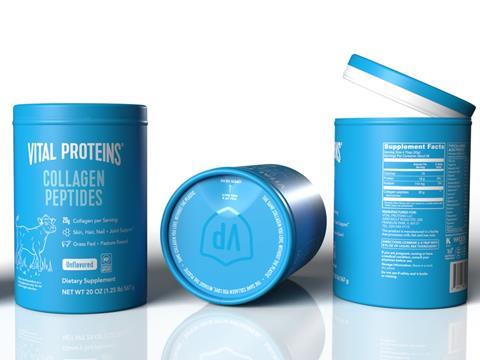
Nestlé has revealed paper-based packaging redesigns across its Smarties, KitKat, and Nescafé brands, among others – aiming to cut one-third of virgin plastics from its product lines and design 95% of its plastic packaging for recycling by 2025.
One of the new packs is a paperboard canister for its Vital Proteins brand in the United States. It features a proprietary ‘rigid and tight’ coverlid for easy opening and closing, prevention of leaks and spillages, and general durability.
Apparently, the change in material and design reduces packaging materials by 90% compared to the previous design.
Nestlé also reports that its global R&D network is working with external partners and suppliers to produce the ‘next generation’ of high-barrier paper packaging solutions in a range of product categories, including coffee products.
“When developing paper packaging, we consider each product’s sensitivity to external elements such as oxygen, temperature and moisture,” says Gerhard Niederreiter, head of Nestlé’s Institute of Packaging Sciences. “Starting with less sensitive products, Nestlé’s paper packaging journey started in confectionery including Smarties and KitKat and is now advancing to product categories such as coffee, which require higher barrier protection.”
“Coffee is particularly sensitive to oxygen and humidity,” explains Axel Touzet, head of the Coffee Business Unit for Nestlé. “This is why redesigning packaging for this product category requires additional efforts to ensure we can safeguard product freshness and quality with science-based and sustainable solutions.”
Previously, Nestlé rolled out a high-barrier paper refill pack for its Nescafé brand in the United Kingdom. Consumers can therefore refill their glass Nescafé jars at home, with the solution said to reduce packaging weight by 97% and consume an average of 60% less plastic than the lid of a 200g glass coffee jar.
It is also reported that the paper refill packs preserve the freshness and quality of the coffee within – and, at end-of-life, are recyclable in the local paper waste stream.
In Europe, the Nescafé Cappuccino range has replaced its previous plastic can with a new pack constituting a paper-based body. Described as another fully recyclable solution in European paper waste streams, it is available in different product varieties across the continent.
Nestlé anticipates that the new designs will help the company reduce its reliance on virgin plastics and ensure that more of its packaging can be recycled.
Earlier this year, we dove into Nestlé’s sustainability-minded packaging progress in 2023. The company claims to have placed 10 billion fewer pieces of packaging on the market than it did in 2022, designed 83.5% of its packaging for recycling, and reached 9.3% recycled content in its plastic packaging.
Furthermore, it estimates that, in 2025, it will reduce its virgin plastic consumption by 33% compared to the 2018 adjusted baseline of 956 kilotonnes. Yet it notes potential roadblocks to further developments, including the availability and cost of alternative materials, alongside the accessibility of waste infrastructure and the development of future regulations.
Other big brands have also been redesigning their packaging in a bid to improve its sustainability. Mondelez International reports that it eliminated over 1,000 tonnes of virgin plastic from its supply chain last year – attributing the reduction to the implementation of 80% post-consumer recycled PET into select Cadbury Milk Tray and Christmas selection packs, to name one example.
Mondelez also claims to have cut the highest tonnage of plastic packaging of any of the signatories of the Ellen MacArthur Foundation’s Global Commitment last year, reaching 12,000 metric tons in 2023. Going forward, it hopes to remove at least 25% of virgin plastic from its rigid packaging, and 5% in its packaging overall, by 2025.
If you liked this story, you might also enjoy:
How are the top brands progressing on packaging sustainability?
Sustainable Innovation Report 2024: Current trends and future priorities
Reuse vs. single use – which is better for the environment?
The ultimate guide to global plastic sustainability regulation


















2 Readers' comments